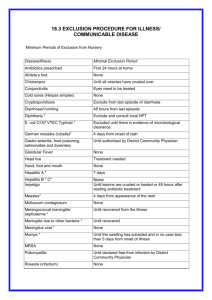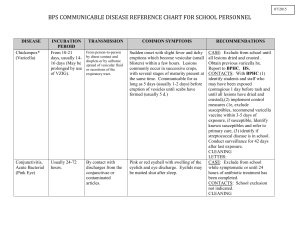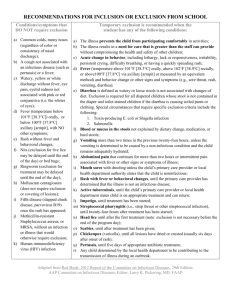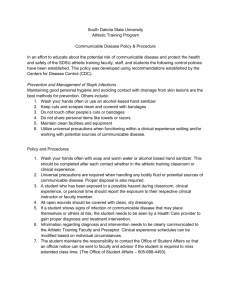COMMUNICABLE DISEASE REFERENCE CHART FOR SCHOOL
advertisement
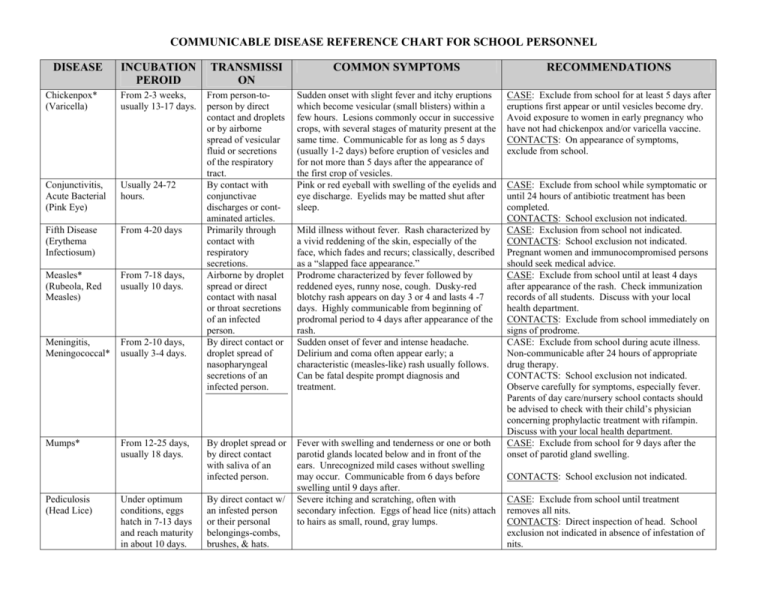
COMMUNICABLE DISEASE REFERENCE CHART FOR SCHOOL PERSONNEL DISEASE INCUBATION PEROID TRANSMISSI ON COMMON SYMPTOMS RECOMMENDATIONS Chickenpox* (Varicella) From 2-3 weeks, usually 13-17 days. Usually 24-72 hours. Sudden onset with slight fever and itchy eruptions which become vesicular (small blisters) within a few hours. Lesions commonly occur in successive crops, with several stages of maturity present at the same time. Communicable for as long as 5 days (usually 1-2 days) before eruption of vesicles and for not more than 5 days after the appearance of the first crop of vesicles. Pink or red eyeball with swelling of the eyelids and eye discharge. Eyelids may be matted shut after sleep. CASE: Exclude from school for at least 5 days after eruptions first appear or until vesicles become dry. Avoid exposure to women in early pregnancy who have not had chickenpox and/or varicella vaccine. CONTACTS: On appearance of symptoms, exclude from school. Conjunctivitis, Acute Bacterial (Pink Eye) Fifth Disease (Erythema Infectiosum) From 4-20 days Measles* (Rubeola, Red Measles) From 7-18 days, usually 10 days. Meningitis, Meningococcal* From 2-10 days, usually 3-4 days. From person-toperson by direct contact and droplets or by airborne spread of vesicular fluid or secretions of the respiratory tract. By contact with conjunctivae discharges or contaminated articles. Primarily through contact with respiratory secretions. Airborne by droplet spread or direct contact with nasal or throat secretions of an infected person. By direct contact or droplet spread of nasopharyngeal secretions of an infected person. Mumps* From 12-25 days, usually 18 days. By droplet spread or by direct contact with saliva of an infected person. Fever with swelling and tenderness or one or both parotid glands located below and in front of the ears. Unrecognized mild cases without swelling may occur. Communicable from 6 days before swelling until 9 days after. Severe itching and scratching, often with secondary infection. Eggs of head lice (nits) attach to hairs as small, round, gray lumps. Pediculosis (Head Lice) Under optimum conditions, eggs hatch in 7-13 days and reach maturity in about 10 days. By direct contact w/ an infested person or their personal belongings-combs, brushes, & hats. Mild illness without fever. Rash characterized by a vivid reddening of the skin, especially of the face, which fades and recurs; classically, described as a “slapped face appearance.” Prodrome characterized by fever followed by reddened eyes, runny nose, cough. Dusky-red blotchy rash appears on day 3 or 4 and lasts 4 -7 days. Highly communicable from beginning of prodromal period to 4 days after appearance of the rash. Sudden onset of fever and intense headache. Delirium and coma often appear early; a characteristic (measles-like) rash usually follows. Can be fatal despite prompt diagnosis and treatment. CASE: Exclude from school while symptomatic or until 24 hours of antibiotic treatment has been completed. CONTACTS: School exclusion not indicated. CASE: Exclusion from school not indicated. CONTACTS: School exclusion not indicated. Pregnant women and immunocompromised persons should seek medical advice. CASE: Exclude from school until at least 4 days after appearance of the rash. Check immunization records of all students. Discuss with your local health department. CONTACTS: Exclude from school immediately on signs of prodrome. CASE: Exclude from school during acute illness. Non-communicable after 24 hours of appropriate drug therapy. CONTACTS: School exclusion not indicated. Observe carefully for symptoms, especially fever. Parents of day care/nursery school contacts should be advised to check with their child’s physician concerning prophylactic treatment with rifampin. Discuss with your local health department. CASE: Exclude from school for 9 days after the onset of parotid gland swelling. CONTACTS: School exclusion not indicated. CASE: Exclude from school until treatment removes all nits. CONTACTS: Direct inspection of head. School exclusion not indicated in absence of infestation of nits. Pertussis* Commonly 6-20 days. By direct contact with respiratory secretions of an infected person by the airborne route. Rubella* (German Measles) From 14-23 days, usually 16-18 days. By direct contact or droplet spread of nasopharyngeal secretions of an infected person. Scabies From 2-6 weeks. By direct skin-toskin contact. Streptococcal Diseases (Including Impetigo and Scarlet Fever) Impetigo: variable, often 1-3 days By direct contact w/ infected persons and carriers or by contact w/ their respiratory droplets. Scarlet Fever: usually 1-3 days, rarely longer. Streptococcal sore throat: short, usually 1-3 days. Tinea Corporis (Ringworm of the Body) From 4-10 days. The initial stage begins with upper respiratory symptoms and increasingly irritating cough. The paroxysmal stage usually follows within 1-2 weeks, and lasts 1-2 months. Paroxysmal stage is characterized by repeated episodes of violent cough broken by a high-pitched aspiratory whoop. Older children may not have it. Recovery may be many wks Mild symptoms; slight fever, rash of variable character lasting about 3 days; enlarged head and neck lymph glands common. Joint pain may occur, especially in older children and adults. Communicable for 7 days before onset of rash and at least 4 days thereafter. Begins as itchy raised areas around finger webs, wrists, elbows, armpits, belt-line, and/or genitalia. Extensive scratching often results in secondary infection. Multiple skin lesions usually of exposed area (e.g., elbows, legs, and knees), but may involve any area. Lesions vary in size and shape, and begin as blisters, which rapidly mature into brown crusts on a reddened base. Healing from center outward produces circular areas, which may resemble ringworm. Fever, sore throat, exudative tonsillitis or pharyngitis. Sandpaper-like rash appears most often on neck, chest, and skin folds of arms, elbows, groin, and inner aspect of thighs. Sudden onset of fever, sore throat, exudative tonsillitis or pharyngitis, and enlarged lymph nodes. Symptoms may even be absent in some cases. Circular well-demarcated lesion that can involve face, trunk, or limbs. Itching is common. CASE: Exclude from school until a physician advises return (usually 5 days after initiation of erythromycin therapy). Discuss with your local health department. CONTACTS: Exclude on first indication of symptoms. CASE: Exclude from school for 7 days after onset of rash. Avoid exposure to women in early pregnancy. Check immunization records of all students. Discuss with your local health department. CONTACTS: Those who are pregnant and not immunized should be urged to seek medical advice. CASE: Exclude from school until 24 hours of antibiotic treatment has been completed. CONTACTS: Direct inspection of body. School exclusion not indicated in absence of infestation. CASE: Exclude from school until lesions are healed or until 24 hours of antibiotic treatment has been completed. CONTACTS: Exclusion from school not indicated. Observe carefully for symptoms. CASE: Exclude from school during acute illness. Non-communicable after 24 hours of appropriate drug therapy. CONTACTS: Exclude on first indication of symptoms. Culturing of school contacts & treatment of carriers not usually indicated. CASE: Exclude from school until 24 hours of antibiotic treatment has been completed. CONTACTS: Exclusion from school not indicated. Observe carefully for symptoms. CASE: Exclusion from school not indicated as long as lesions are covered or child is receiving treatment. During treatment, exclude from gymnasiums and swimming pools. CONTACTS: School exclusion not indicated. By direct/indirect contact with lesions of an infected/contaminated person/environment al surfaces. NOTE:A more complete discussion of these conditions and other communicable diseases may be found in Control Communicable Diseases Manual (1995) published by the American Public Health Association. Additional information and consultation are also available through your local health department. Virginia Department of Health, Office of Epidemiology, P.O. Box 2448, Room 113, Richmond, Virginia 23218. Please visit our web site at www.vdh.state.va.us. *Officially reportable in Virginia to the local health department. All outbreaks and unusual occurrences of disease are also reportable.
